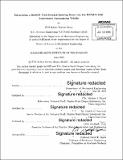| dc.contributor.advisor | Michael J. Ricard and Camila C. Francolin. | en_US |
| dc.contributor.author | Bruss, Robert Everett | en_US |
| dc.contributor.other | Massachusetts Institute of Technology. Department of Mechanical Engineering. | en_US |
| dc.date.accessioned | 2015-12-03T20:56:22Z | |
| dc.date.available | 2015-12-03T20:56:22Z | |
| dc.date.copyright | 2015 | en_US |
| dc.date.issued | 2015 | en_US |
| dc.identifier.uri | http://hdl.handle.net/1721.1/100146 | |
| dc.description | Thesis: S.M., Massachusetts Institute of Technology, Department of Mechanical Engineering, 2015. | en_US |
| dc.description | Cataloged from PDF version of thesis. | en_US |
| dc.description | Includes bibliographical references (page 75) | en_US |
| dc.description.abstract | With the rapid increase in the availability and capability of robotic technology in the 21st century, unmanned vehicles have started to play a larger role accomplishing mundane, unpleasant, and dangerous tasks around the world. While their operations have not garnered them high visibility in the media, Unmanned Underwater Vehicles (UUVs) are playing an increasingly important role in both private and military operations. This thesis follows the process of integrating an advanced forward looking sonar (FLS) onto an existing UUV to increase object detection, avoidance, and classification capabilities. Conceptualization of the new vehicle hardware utilized computer-aided design to meet design requirements while maintaining all functions of the original vehicle. In order to minimize weight and manufacturing complexity, the structural design was then analyzed and optimized using finite element analysis. After a final design was submitted for review, computational fluid dynamics methods were used to quantify the lift and drag induced on the vehicle by the new FLS nose. This thesis also explores the broader hydrodynamic implications of utilizing angled faces on the nose of torpedo-like UUVs. At the time of publication, the author has submitted the proposed FLS nose integration design for review and for hopeful deployment in the summer of 2015. | en_US |
| dc.description.statementofresponsibility | by Robert Everett Bruss. | en_US |
| dc.format.extent | 75 pages | en_US |
| dc.language.iso | eng | en_US |
| dc.publisher | Massachusetts Institute of Technology | en_US |
| dc.rights | M.I.T. theses are protected by copyright. They may be viewed from this source for any purpose, but reproduction or distribution in any format is prohibited without written permission. See provided URL for inquiries about permission. | en_US |
| dc.rights.uri | http://dspace.mit.edu/handle/1721.1/7582 | en_US |
| dc.subject | Mechanical Engineering. | en_US |
| dc.title | Integrating a RESON 7131 forward looking sonar into the REMUS 2500 underwater autonomous vehicle | en_US |
| dc.title.alternative | Integrating a RESON 7131 FLS into the REMUS 2500 UAV | en_US |
| dc.type | Thesis | en_US |
| dc.description.degree | S.M. | en_US |
| dc.contributor.department | Massachusetts Institute of Technology. Department of Mechanical Engineering | |
| dc.identifier.oclc | 930150159 | en_US |
